INFORMATION LEAFLET NO 1
THE MIDLAND RAILWAY AMBULANCE ORGANISATION
During the second half of the nineteenth and early part of the twentieth century, the railway network of the United Kingdom expanded rapidly, both in terms of geographical coverage and the amount of freight and number of passengers carried. Operating the railway was intrinsically hazardous in those days. Rules, procedures and equipment were introduced from the beginning, and developed with time, to make the running of the railway as safe as possible. Nevertheless, accidents to people – particularly staff – were all too common. Accidents involving injuries to members of the public had to be notified to the Board of Trade (later the Department of Transport) and the more serious would be the subject of an official enquiry by the Railway Inspectorate and the subsequent report (with recommendations to improve safety, if relevant) made public.
The railway companies were very well aware of the need to minimise accidents wherever possible. It should be remembered that “emergency services” in the form we know them today did not exist. It could take a long time to get an injured person to hospital or to get a doctor to attend the scene of an accident. It was therefore very important for survival of the injured that “first aid” be administered quickly and effectively
The Midland Railway (along with other companies) encouraged their staff to train in “first aid”. This was often done in conjunction with the St John Ambulance organisation and local doctors. Having reached a proficient standard, staff were entitled to wear a circular badge on their uniform (often on the sleeve). There were a number of designs – the two most common being gilt enamelled (Fig 5) and plain nickel (Fig 6).
Stretchers and “Ambulance Boxes” (first aid kits) were located widely all over the Midland system. It is interesting that, at their largest marshalling yard at Toton (near Long Eaton in Nottinghamshire), the Midland kept a specially fitted goods brake van in a convenient siding to be used as an ambulance for transporting a casualty to hospital. An engine would be taken off its normal duties to make a special trip to Nottingham station, whence the casualty would be transferred to hospital. Use of the railway in this way provided the quickest means of transport.
To recognise an employee’s skilled application of first aid, the company introduced a series of medals and certificates which were awarded for “first aid rendered” to a casualty after an accident. There were three medals: gold, silver and bronze, which reflected the degree of skill used by the “first aider” in tending the casualty’s injuries. Examples of these medals are illustrated (Figs 1 to 4). Certificates were also awarded to accompany the medal.
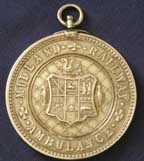
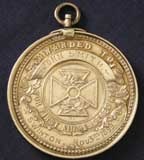
Fig 1:
The “large” (2.0in. diam) silver medal which was superseded by the smaller version (Fig 3) circa 1900. It is not known whether there were gold and bronze versions in this larger size. [RFB12894]
Whilst the bronze medal was issued as a reward for passing the three required examinations to become a fully qualified first aider, the gold and silver medals were awarded to recognise first aid actually being rendered. Somewhat bizarrely to modern eyes, the individual giving the first aid was expected to fill in a form to apply for a medal, rather than being nominated. The application had to be signed-off by a doctor who certified that aid rendered was in accordance with the training. (It seems that the aid doesn't necessarily have to be successful as a medal could be awarded even if the victim could not be saved).
All this was administered by an Ambulance Committee operating under the auspices of the General Manager's Office at Derby, but having senior representatives of most departments sitting upon it. From its inception in May 1911, continuing with the Company becoming part of the LMS, the secretary of the Ambulance Committee was Herbert Edmund Richardson (1868-1931).
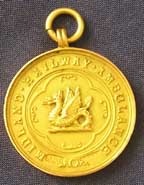
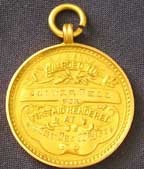
Fig 2:
The gold medal (1.25in. diam) [RFB12897]
Each year in November a ceremony would be held in the Midland Railway Institute at Derby where H.E. Richardson would present a report and the medals were distributed. Proceedings were usually covered by the local newspapers, notably the Derby Daily Telegraph, and a list of all recipients and their stations reported. Very regrettably, this seems to be the only form of historical record which has survived and provides no extra information than appears on the medals themselves.
Many accidents occurred in circumstances not involving moving trains e.g. when operating equipment and when loading and unloading trucks and vans. All accidents which were “reportable” to the Board of Trade were recorded in the annual railway accident summaries published by the Board, but the minor ones only appear as part of the statistical summaries where no details are given. However, the more serious accidents are recorded individually. In the worst cases, very full reports are published, including verbatim accounts of witness statements.

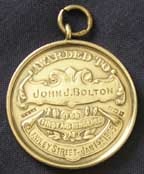
Fig 3:
The “small” silver medal (1.25in. diam) [RFB12888]
A significant number of medals have survived to come into the possession of the descendants of the original recipient, giving rise to questions about the circumstances in which the medal was awarded. The two principal sources of information are contemporary local newspaper reports and the Board of Trade annual accident reports. The latter are available in the National Archives at Kew, whilst copies of most of the major reports of accidents on the Midland Railway are available for reference in the Midland Railway Study Centre at Derby. For details of how to make an appointment, please visit this page.
However, it is sadly evident that many accidents and mishaps which resulted in the award of an Ambulance Medal happened beyond the view of the public and were otherwise never reported or recorded. Whilst a form will have been filled-in and submitted to the Ambulance Committee, so far as is currently known, none of these completed forms have survived. Consequently, the circumstances behind the vast majority of awards are likely to be forever lost to history.
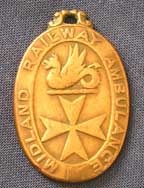
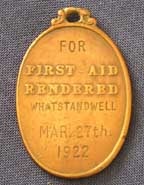
Fig 4:
The bronze medal [RFB12889]
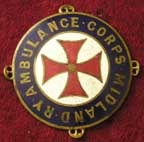
Fig 5:
The gilt enamel ambulance badge with four lugs for sewing onto the uniform [RFB12903]
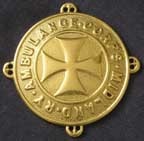
Fig 6:
The plain nickel version of the ambulance badge [RFB12901]
You can download a copy of a Midland Railway document from 1901 (RFB02902) which gives even more detail about the Company's First Aid courses and Ambulance awards.
The above items belong to the Roy F Burrows Collection of the Midland Railway Society and are available to view by prior appointment in the Study Centre.